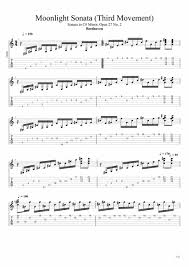The Beauty of Moonlight Sonata 3rd Movement Sheet Music
Beethoven’s Moonlight Sonata, specifically the 3rd movement, is a masterpiece that has captivated musicians and music lovers for centuries. The intricate harmonies, dramatic dynamics, and emotional depth of this piece make it a challenging yet rewarding choice for pianists looking to push their boundaries.
Obtaining the sheet music for the 3rd movement of Moonlight Sonata allows musicians to delve into Beethoven’s genius firsthand. The notation on the sheet music reveals the complex interplay of melodies and rhythms that create the hauntingly beautiful soundscape of this movement.
Studying the sheet music for Moonlight Sonata’s 3rd movement provides insight into Beethoven’s compositional techniques and artistic vision. Pianists can analyze the phrasing, articulation, and tempo markings to interpret the piece in their unique way while staying true to Beethoven’s original intentions.
Playing from the sheet music of Moonlight Sonata’s 3rd movement challenges pianists to master technical skills such as rapid arpeggios, precise fingerwork, and dynamic control. The intricate passages demand focus, discipline, and dedication to achieve a performance that captures the essence of Beethoven’s musical legacy.
Whether you are a seasoned pianist seeking a new musical challenge or an aspiring musician looking to explore classical repertoire, delving into Moonlight Sonata’s 3rd movement sheet music offers a profound musical experience. Embrace the beauty and complexity of Beethoven’s composition as you embark on a journey through one of classical music’s most iconic pieces.
Mastering Beethoven’s Moonlight Sonata: 5 Essential Tips for Perfecting the Third Movement
- Practice slowly and gradually increase the speed to maintain accuracy.
- Pay attention to dynamics for expressive playing.
- Focus on hand coordination for the fast passages.
- Use pedal judiciously to enhance the overall sound without muddying it.
- Take regular breaks to prevent fatigue and maintain focus during practice sessions.
Practice slowly and gradually increase the speed to maintain accuracy.
Practicing slowly and gradually increasing the speed when learning the Moonlight Sonata’s 3rd movement sheet music is essential for maintaining accuracy and mastering the piece. By starting at a comfortable pace, pianists can focus on precision, finger placement, and musical expression without sacrificing accuracy. As proficiency improves, gradually speeding up the tempo allows for a smooth transition while ensuring that each note and passage remains clear and controlled. This methodical approach not only enhances technical proficiency but also helps in capturing the emotional depth and intensity of Beethoven’s composition with finesse.
Pay attention to dynamics for expressive playing.
To truly capture the emotional depth and beauty of Beethoven’s Moonlight Sonata 3rd movement, it is crucial to pay close attention to dynamics while playing from the sheet music. Dynamics, such as pianissimo, fortissimo, crescendo, and decrescendo markings, provide the roadmap for expressive interpretation. By varying the volume and intensity of each note and passage according to these markings, pianists can infuse their performance with nuance, drama, and sensitivity. Mastering dynamics not only enhances the musicality of the piece but also allows for a more profound connection with the composer’s intentions, resulting in a captivating and moving rendition of this iconic composition.
Focus on hand coordination for the fast passages.
To master the 3rd movement of Moonlight Sonata, focusing on hand coordination is crucial, especially during the fast passages. The intricate and rapid arpeggios demand precise synchronization between both hands to maintain clarity and fluidity in performance. By honing your hand coordination skills through dedicated practice and attention to detail, you can navigate the challenging passages with ease and confidence, bringing out the full brilliance of Beethoven’s composition.
Use pedal judiciously to enhance the overall sound without muddying it.
When approaching the Moonlight Sonata’s 3rd movement sheet music, it is essential to use the pedal judiciously to elevate the overall sound quality without muddying its intricate nuances. The pedal can be a powerful tool in creating a sense of resonance and blending harmonies, but overusing it can result in a blurred and indistinct sound. By applying the pedal thoughtfully and selectively, pianists can enhance the musical phrasing and dynamics of the piece while maintaining clarity and precision in their performance.
Take regular breaks to prevent fatigue and maintain focus during practice sessions.
Taking regular breaks while practicing Moonlight Sonata’s 3rd movement sheet music is essential to prevent fatigue and sustain focus throughout your practice sessions. By incorporating short breaks into your practice routine, you give your mind and body a chance to rest and recharge, allowing you to approach the piece with renewed energy and concentration. These breaks not only help prevent physical strain but also promote mental clarity, ensuring that you can maintain a high level of performance quality as you work through the intricate passages and technical challenges of this demanding composition.

